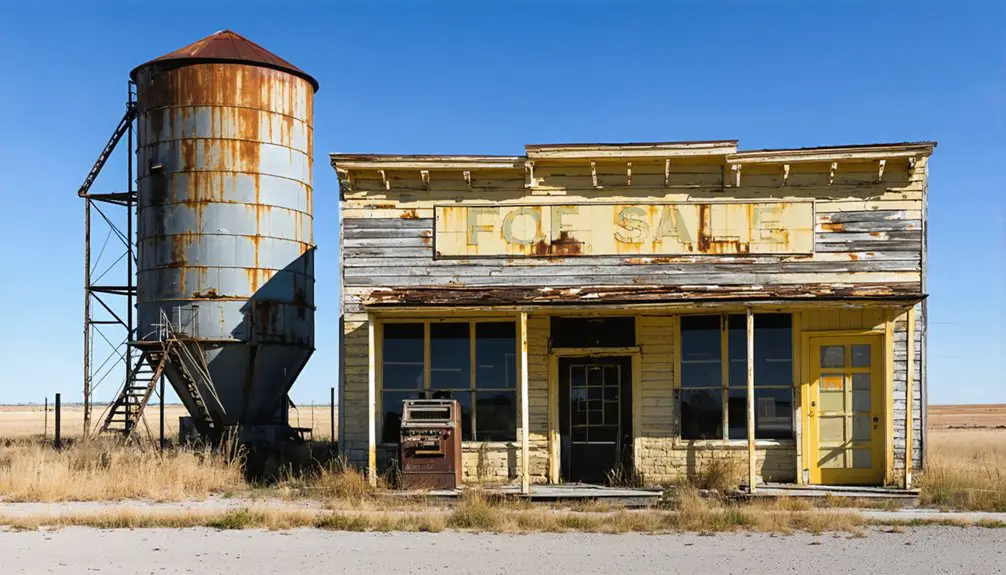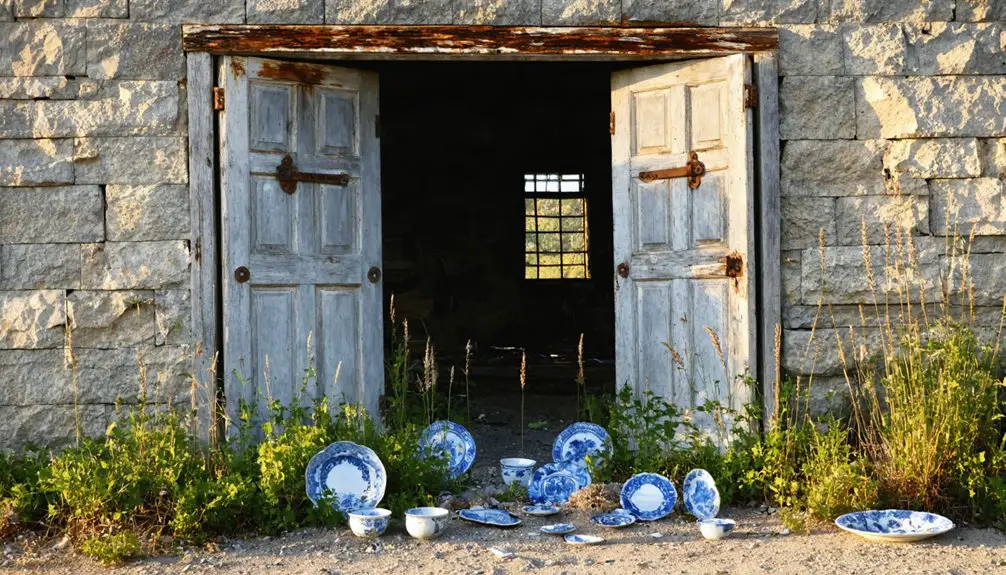You’ll find Mariposa in eastern Kansas’s Linn County, where it briefly emerged as a frontier settlement in 1857. Founded by the Buchanan Town Company during the Bleeding Kansas period, the town struggled from the start with only two of eight log cabins ever occupied. Without railroad access or essential infrastructure, Mariposa couldn’t compete with neighboring towns. While few physical traces remain today, the site holds rich archaeological evidence of both pioneer and indigenous life.
Key Takeaways
- Mariposa was established in Kansas’s Linn County in 1857 but quickly failed due to harsh conditions and limited infrastructure.
- Only two of eight planned log cabins were ever occupied, reflecting the settlement’s struggle to attract permanent residents.
- The town’s lack of railroad access, unlike thriving nearby settlements, significantly contributed to its eventual abandonment.
- Archaeological evidence reveals centuries of human habitation, including indigenous settlements and pioneer-era artifacts.
- The ghost town represents broader patterns of 19th-century frontier development and settlement failures in Kansas Territory.
The Brief Rise and Fall of Mariposa
While the specific details of Mariposa’s founding remain unclear, this Kansas ghost town represents one of many communities that disappeared from the state’s landscape during periods of economic and social change.
Like other settlements in the region, Mariposa’s existence was likely shaped by the complex settlement patterns that characterized Kansas’s development.
The town emerged during a time when Native American tribes were being forcibly relocated across Kansas through federal removal policies.
Similar to Columbia’s experience with severe flooding, natural disasters and destructive floods often threatened the survival of early Kansas settlements.
You’ll find that the town’s story mirrors many others across the state, where social dynamics and economic factors determined a community’s fate.
Railroad access, or lack thereof, often played a decisive role in these towns’ survival.
Agricultural challenges and shifting population demographics could have contributed to Mariposa’s decline, as residents sought opportunities elsewhere.
The town’s abandonment reflects the broader pattern of rural depopulation that transformed many Kansas communities into ghost towns.
Geographic Location and Natural Resources
The ghost town of Mariposa sat in eastern Kansas’s Linn County at approximately 38.258°N latitude and 94.954°W longitude, roughly 12 miles northwest of Sugar Mound.
The town’s geographic significance stemmed from its position in the Kansas Territory during mid-19th century settlement, where it occupied gently rolling plains typical of the region’s terrain.
You’ll find the land supported mixed grasslands and farmland, with fertile loamy soils that promised agricultural potential.
While the area lacked major mineral deposits or timber resources, its resource sustainability centered primarily on farming capabilities.
The settlement relied on small streams or wells for water, as no major water bodies were documented nearby.
The continental climate, marked by hot summers and cold winters, along with variable rainfall patterns, likely influenced the town’s ultimate fate. Modern weather readings from similar latitudes show clear sky conditions are common in this region.
Much like Keokuk, Kansas, Mariposa represented one of many small settlements that emerged during the territorial expansion period.
Early Settlement Attempts and Challenges
Settlement of Mariposa began in 1856 when Preston B. Plumb, along with Maj. Pierce and Mr. Hunter, established the first settlement attempt at the mouth of the Saline River.
Their settlement motivations were likely speculative, as you’ll find many similar ventures followed the Kansas-Nebraska Act. The community dynamics proved unstable, and despite building a cabin and digging a well, the settlement quickly failed. The area remained unorganized territory until 1859, making formal development difficult. Much like the native societies that had lived in other Mariposa regions for thousands of years, the settlers faced significant adaptation challenges.
- Harsh natural conditions and limited water sources challenged survival
- Lack of infrastructure and basic amenities deterred permanent residents
- Political turmoil and territorial conflicts created an unstable environment
- Absence of railroads and trade routes hindered economic growth
- Competing towns drew potential settlers away from Mariposa
Key Historical Figures and Town Planners
Mr. Hunter joined Preston B. Plumb in 1856 with plans to establish a thriving settlement at the mouth of the Saline River.
You’ll find that Hunter’s development vision focused on creating a sustainable community through the construction of essential log structures and basic infrastructure.
Major Pierce complemented these efforts by implementing settlement strategies that aimed to attract permanent residents to the fledgling town of Mariposa.
Similar to many settlements during the Bleeding Kansas period, the town faced significant challenges.
Unfortunately, like the first settlement established by Plumb, Mariposa was ultimately abandoned.
Hunter’s Development Vision
During Mariposa’s formative years, Hunter emerged as a pivotal figure who shaped the town’s development through his extensive vision for infrastructure and economic growth. His strategic approach to community layout emphasized practical design and resource accessibility, ensuring residents could easily reach essential natural assets like creeks and forests. Similar to how Cyrus Archer established key buildings in Densmore, Kansas, Hunter’s careful planning left a lasting mark on the town’s infrastructure.
Hunter’s development priorities included:
- Creating functional town layouts supporting both commerce and housing
- Establishing transportation routes to connect with broader trade networks
- Building crucial civic structures like courthouses and schools
- Positioning mining as the economic cornerstone
- Integrating logging operations to support construction and trade
You’ll find Hunter’s influence reflected in the town’s careful planning for sustainability and growth, particularly in how he addressed challenges like natural disasters and population fluctuations through resilient infrastructure designs. Like the original Mariposa in California, the town faced significant challenges when a devastating major flood in 1849 required strategic relocation and rebuilding efforts.
Pierce’s Settlement Strategy
While President Franklin Pierce championed the Kansas-Nebraska Act of 1854, his settlement strategy for towns like Mariposa reflected broader political tensions over slavery in America’s expanding territories.
Pierce’s political maneuvering centered on popular sovereignty, allowing settlers to determine slavery’s status locally rather than through federal mandate.
Working with Senator Stephen Douglas, Pierce leveraged presidential powers and patronage to push the Act through Congress, making it a loyalty test for Northern Democrats.
His settlement motivations prioritized appeasing Southern interests over establishing stable governance structures.
This approach contributed to violent confrontations in “Bleeding Kansas,” directly impacting communities like Mariposa.
As the Democratic Party fractured and Northern opposition mounted, Pierce’s strategy ultimately undermined the orderly development of Kansas territories, leaving towns vulnerable to factional conflicts.
Economic Factors Behind the Abandonment

As the Buchanan Town Company established Mariposa in 1857, the settlement’s economic foundation proved too weak to sustain long-term growth. The economic decline was swift and unforgiving, with only two of eight log cabins ever occupied.
Without robust industries or commerce to support community resilience, Mariposa couldn’t weather the challenges ahead.
The settlement’s fate was sealed by several vital factors:
- Lack of sustainable industries or commercial establishments to provide employment
- Absence of essential infrastructure like banks, mills, or manufacturing facilities
- Agricultural downturn and farm consolidation reducing local population density
- Limited property values that discouraged further economic investment
- Outmigration of younger generations seeking better opportunities elsewhere
These economic pressures ultimately led to Mariposa’s complete abandonment, making it one of Kansas’s many ghost towns.
Transportation Networks and Regional Impact
Despite Mariposa’s strategic location near the Saline River, the settlement failed to establish itself within Kansas’s essential transportation networks of the 1850s. While you’d have found the Santa Fe Trail bringing migrants and freight through the region, Mariposa couldn’t capitalize on this early transportation evolution.
You’ll notice how the arrival of railroads transformed nearby towns like Caldwell, where population soared from 260 to 1,500 residents. The economic connectivity provided by rail systems revolutionized cattle transport and commerce throughout Kansas.
Towns that secured railroad stations thrived, developing sophisticated traffic control systems like Beaumont’s Mariposa Tower. But without a direct rail connection or position as a major transport junction, Mariposa’s potential for growth vanished, highlighting how critical transportation access was to a settlement’s survival.
Archaeological Evidence and Remaining Traces

The rich archaeological record of Mariposa’s region reveals thousands of significant artifacts, from worked stone tools and flints to pottery sherds and arrowheads. Evidence of indigenous habitation spans centuries, with archaeological artifacts scattered across valley floors and bluffs, indicating a thriving population that may have reached tens of thousands.
- Blackened soil and cooking pot remains mark ancient campfire sites
- Local construction and farming activities regularly uncover new artifact collections
- Private collections house numerous archaeological finds in boxes and coffee cans
- Settlement traces suggest over 200 years of continuous occupation
- While few structural remains exist today, domestic dwelling sites are marked by pottery and hearth remnants
Today’s ghost town landscape shows minimal above-ground structures, though evidence points to what was once one of the largest indigenous communities in present-day United States.
Legacy in Kansas Settlement History
Moving beyond physical artifacts, Mariposa’s broader significance emerges through its role in Kansas settlement patterns.
You’ll find it represents a common story of 19th-century frontier development, where small communities sprouted along transportation routes to support the agricultural economy.
Like many of its contemporaries, Mariposa served as a essential hub for pioneer life, offering fundamental services such as blacksmithing and general stores.
These settlements formed significant nodes in the expanding frontier, enabling trade and social interaction among settlers.
You can trace how changing transportation priorities, particularly railroad realignments, influenced the town’s fate.
While Mariposa’s physical presence has faded, its legacy persists through local place names and family histories, offering valuable insights into how economic shifts and migration patterns shaped Kansas’s development during the settlement era.
Preservation Efforts and Historical Records

While preservation efforts for Mariposa remain minimal, historical records paint a sparse picture of this short-lived Kansas settlement. The primary historical documentation comes from territorial archives and the KSGenWeb project, revealing its brief establishment in 1856 by Preston B. Plumb and associates.
- Only a cabin and well were ever constructed on the site.
- No active preservation organizations exist specifically for Mariposa.
- The town’s swift abandonment left minimal physical remnants to preserve.
- Regional ghost town preservation efforts focus on larger, more documented sites.
- Most records link to the “Buchanan Town company” charter from the same period.
You’ll find that Mariposa’s preservation challenges mirror those of many Kansas ghost towns, where lack of structures and limited historical significance make formal preservation difficult.
Digital archiving has become the primary means of maintaining its memory.
Frequently Asked Questions
Were There Any Notable Native American Settlements Near Mariposa Before Its Founding?
You’ll find Indigenous heritage was prominent there, with Wichita and Kanza settlement patterns including earth-lodge villages along nearby Arkansas River valleys, where they farmed and hunted before European colonization.
What Happened to the Original Landowners After Mariposa Was Abandoned?
Picture Richard Mobley’s tragic departure: You’ll find most landowners, like him, simply left after abandonment. They didn’t maintain property claims, and there weren’t any recorded disputes over the deserted lands.
Did Any Seasonal Festivals or Cultural Events Take Place in Mariposa?
You won’t find documented evidence of seasonal celebrations or cultural traditions in historical records, though it’s likely the town followed typical pioneer community patterns of gatherings before its abandonment.
Were There Any Documented Crime Incidents During Mariposa’s Brief Existence?
While you might expect frontier lawlessness, there’s no documented crime history in Mariposa. With just two occupied cabins and no established law enforcement, the settlement was abandoned before any criminal incidents were recorded.
What Types of Buildings or Structures Were Initially Planned for Mariposa?
You’ll find the initial construction plans were quite basic, with architectural plans only including a simple cabin and well for essential needs. There weren’t any major commercial or civic structures planned.
References
- https://www.yosemite.com/yosemite-mariposa-county-region/southern-mariposa-county/hornitos-ca/
- https://www.legendsofamerica.com/tx-terlingua/
- http://www.ksgenweb.org/archives/1912/s/saline_county.html
- https://www.youtube.com/watch?v=alC1wDdSVvg
- https://en.wikipedia.org/wiki/List_of_ghost_towns_in_Kansas
- https://dianastaresinicdeane.wordpress.com/2012/01/29/columbia-a-kansas-ghost-town-story/
- https://legendsofkansas.com/kansas-time-line/
- https://en.wikipedia.org/wiki/History_of_Kansas
- https://www.youtube.com/watch?v=OyBXD18P_j4
- https://freepages.rootsweb.com/~gtusa/history/usa/ks.htm



